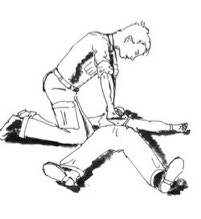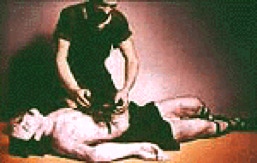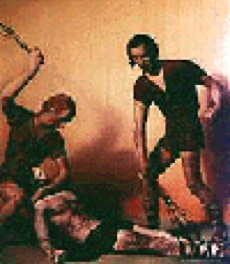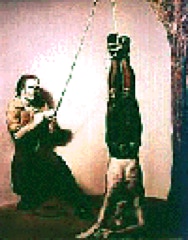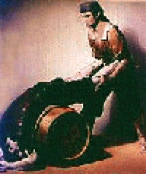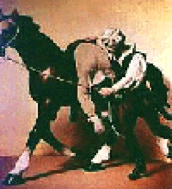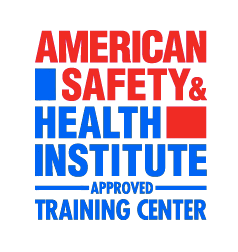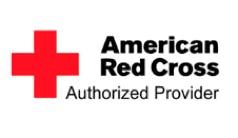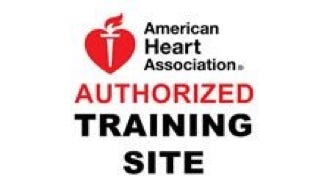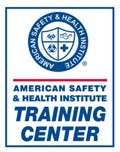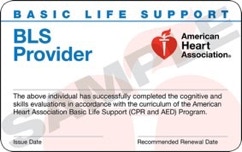CPR Myths and Popular Culture
The CPR resuscitation technique that many of us older readers may first remember was described in the first edition of the Boy Scout Handbook in the United States in 1911, as a form of artificial respiration where the person was laid on their front, with their head to the side, and a process of lifting their arms and pressing on their back was utilized, essentially the Silvester Method with the patient flipped over. This form is seen well into the 1950's (it's used in an episode of Lassie during the Jeff Miller era), and was often used, sometimes for comedic effect, in theatrical cartoons of the time (see Tom and Jerry's "The Cat and the Mermouse"). This method of CPR would continue to be shown, for historical purposes, side-by-side with modern CPR in the Boy Scout Handbook until its ninth edition in 1979. However it wasn't until the middle of the 20th century that the wider medical community started to recognize and promote it as a key part of resuscitation following cardiac arrest. Peter Safar wrote the book ABC of resuscitation in 1957. In the U.S., it was first promoted as CPR for the public to learn in the 1970s. Early overly aggressive marketing efforts oversold the effectiveness of CPR in rescuing heart attack and other victims, and this misperception continues even today.
CPR is often severely portrayed in movies and television as being highly effective in resuscitating a person who is not breathing and has no circulation. A 1996 study by the New England Journal of Medicine showed that CPR success rates in television shows was 75%. The real survival rate of an unwitnessed, out-of-hospital sudden cardiac arrest is in a range of 6% to admission and even less to hospital discharge. The current rise in the distribution and use of Automated External Defibrillators (AED's) is improving the survival rate dramatically.
3000 BC
Mayan hieroglyphics and Peruvian Incas performed resuscitation by rectal fumigation. One can only surmise that while not very successful this technique certainly kept anyone from faking a heart attack to get off work for the day.
896 BC Biblical Reference to Resuscitation
The first description of a successful resuscitation is recounted in the Bible, in the Book of Kings. A child of a Shunemite couple complained of a headache and died. The prophet Elisha prayed and then: "...placed himself over the child. He put his mouth on his mouth, his eyes on his eyes, and his hands on his hands, as he bent over him. And the body of the child became warm. He stepped down, walked once up and down the room, then mounted and bent over him. Thereupon the boy sneezed seven times, and the boy opened his eyes." (2 Kings, iv, 34.)
500-1500 AD
Various methods including flagellation, external heating, rolling over a barrel, or strapping across the back of a horse which then ran around a field. The first report of an experimental intubation of the trachea was probably by the great Muslim philosopher and physician Avicenna (Abu Ali Al-Hussein Ibn Abdallah Ibn Sinna) in approximately the year 1000. "When necessary, a cannula of gold, silver or another suitable material is advanced down the throat to support inspiration." Andreas Versalius published "De humani corporis fabric-a" which described blowing into a tube to resuscitate an animal.
Early Ages- The Heat Method
Very early in our history, people realized that the body became cold when lifeless and connected heat with life. In order to prevent death from taking the person, the body was warmed. The use of warm ashes, burning excrement, or hot water placed directly on the body were all employed in an attempt to restore life. Undoubtably this technique had rather limited success over the years.
Early Ages - Flagellation Method
In the early ages, the would-be rescuers would actually whip the victim in an attempt to stimulate some type of response.
1530 - Bellows Method
In the 1500's it was not uncommon to use a bellows from a fireplace to blow hot air and smoke into the victim's mouth, a method that was used for almost 300 years. Unfortunately, not many people carried fireplace bellows with them, but the success of this procedure motivated various manufacturers to design and manufacture Bag-Valve-Mask Resuscitators.
However, in those days, the medical authorities were not aware of the anatomy of the respiratory system and did not appreciate the need to extend the victim's neck in order to obtain a clear airway. Phillipus von Hohenheim wrote about using a bellows to resuscitate people 1493-1541
In 1829, Leroy d'Etiolles demonstrated that over distention of the lungs by bellows could kill an animal, so this practice was discontinued.
1711 - Fumigation Method
In the 1700's a new method of resuscitation was used. This "new" procedure involved blowing tobacco smoke into the victim's rectum. According to the literature, smoke was first blown into an animal bladder, then into the victim's rectum. It was used successfully by North American Indians and American colonists an introduced in England in 1767.
This practice was abandoned in 1811 after research by Benjamin Brodie when he demonstrated that four ounces of tobacco would kill a dog and one ounce would kill a cat.
1740-Mouth to Mouth
The Paris Academy of Sciences officially recommended mouth-to-mouth resuscitation for drowning victims.
1770 - Inversion Method
Other methods were developed in the 1700's in response to the leading cause of sudden death of that time, drowning. Inversion was originally practiced in Egypt almost 3,500 years before and it again became popular in Europe. This method involved hanging the victim by his feet, with chest pressure to aid in expiration and pressure release to aid inspiration.
In response to the increasing numbers of drowning during this time period, societies were formed to organize efforts in resuscitation. England's Royal Humane Society was founded in 1774. Although it was the most famous, it was not the first. It was preceded by the Dutch Society for Recovery of Drowned Persons, established in 1767. The Dutch recommendations included:
Warming the victim (which sometimes required transporting the body to a different location) by lighting afire near the victim, burying him in warm sand, placing the body in a warm bath, or placing in a bed with one or two volunteers;
Removing swallowed or aspirated water by positioning the victim head lower than his feet and applying manual pressure to the abdomen, vomiting was induced by tickling the back of the throat with a feather;
Stimulation of the victim, especially the lungs, stomach and intestines by such means as rectal fumigation with tobacco smoke, or the use of strong odors;
Restoring breathing with a bellows;
Bloodletting.
These and other methods had been applied for years as documented in the report of Anne Green's hanging, resuscitation and recovery in 1650.
Other methods included physical and tactile stimulation in an attempt to "wake up" the victim. Yelling, slapping, even whipping were used to attempt to resuscitate.
1773 - Barrel Method
In an effort to force air in and out of the victim's chest cavity, the rescuer would hoist the Victim onto a large wine barrel and alternately roll him back and forth. This action would result in a compression of the victim's chest cavity, forcing air out, and then a release of pressure which would allow the chest to expand resulting in air being drawn in. This technique was in many ways a precursor to modern CPR techniqes as it attempted to force air in and out of the lungs.
1778 Defibrillation First Suggested
Goodwin and Kite deduced that asphyxia causes the heart to stop. Kite suggested electric shock treatment (defibrillation). However, airway problems produced by the tongue were not appreciated.
1803 - Russian Method
This concept involved reducing the body's metabolism by freezing the body under a layer of snow and ice. Unfortunately, what the medical authorities did not realize at the time, was that the most critical organ which needed to be frozen in order to accomplish a reduction of the body's metabolism was the brain.
1812 - Trotting Horse Method
In 1812 Lifeguards were equipped with a horse which was tied to the Lifeguard station. When a victim was rescued and removed from the water, the Lifeguard would hoist the victim onto his horse and run the horse up and down the beach. This resulted in an alternate compression and relaxation of the chest cavity as a result of the bouncing of the body on the horse. This procedure as banned across the United States in 1815 as a result of complaints by "Citizens for Clean Beaches".
1850 Mouth to Mouth
Mouth to Mouth replaced chest pressure except for babies resuscitated by midwives. Anesthetics were also introduced in 1850, resulting in an increase in respiratory arrest in people under medical supervision!
1856 - Roll Method
As late as 1856, manual ventilation was given low priority, concentration was on maintaining body heat. These were the same recommendations as provided by the Dutch nearly 100 years earlier. A significant change in priorities occurred when Marshall Hall challenged the conventional wisdom of the Society. His contention that time was lost transporting the victim; that the restoration of warmth without some type of ventilation was detrimental; that fresh air was beneficial; and that if left in the supine position, the victim's tongue would fallback and occlude the airway.
Because the bellows were no longer an option, Marshall Hall developed a manual method in which the victim was rolled from stomach to side 16 times a minute. In addition, pressure was applied to the victim's back while the victim was prone (expiratory phase). Tidal volumes of 300 ml to 500 ml were achieved and soon became adopted by the Royal Humane Society.
1858 Silvester method introduced
A now obsolete method of artificially resuscitating still-born children, and for restoring persons apparently drowned or dead. The patient would be on his or her back, with arms raised to the sides of the head, held there temporarily, then brought down and pressed against the chest. Movement repeated 16 times per minute.
1891-First Modern Chest Compressions
Dr. Friedrich Maass performed the first equivocally documented chest compression in humans.
Late 1892 - Tongue stretching
Other methods still used included stretching the rectum, rubbing the body, tickling the throat with a feather, waving strong salts, such as ammonia, under the victim's nose. In 1892, French authors recommended tongue stretching. This procedure was described as holding the victim's mouth open while pulling the tongue forcefully and rhythmically.
1932 Holger-Neilson
Prone position, hands under head, expire by pressing on chest, inspire by lifting elbows.
1947 First successful defibrillation
1954 Mouth to Mouth Advances
James Elam was the first to prove that expired air was sufficient to maintain adequate oxygenation and by 1956 Peter Safar and James Elam invented mouth-to-mouth resuscitation. 1957 The United States military adopted the mouth-to-mouth resuscitation method to revive unresponsive victims.
1960 - Cardiac Massage
The next major step in resuscitation was closed chest massage which was introduced in the 1960's by Dr. Kowenhoven, The crucial aspect of this technique is that the patient receives oxygen which is transported to the brain by the development of a minimal blood circulation. On this basis many national and international guidelines to perform CPR came out. The American Heart Association started a program to acquaint physicians with close-chest cardiac resuscitation and became the forerunner of CPR training for the general public.
1972 - CPR practice for the population
1972 Leonard Cobb held the world's first mass citizen training in CPR in Seattle, Washington called Medic 2. He helped train over 100,000 people the first two years of the programs. During the Vietnam War the US army introduced CPR to the people for the first time. Then, in 1973 the American Red Cross and the American Heart Association (AHA) began a big campaign to teach the American population this method.
Highlights of the History of Cardiopulmonary Resuscitation (CPR)
1740 The Paris Academy of Sciences officially recommended mouth-to-mouth resuscitation for drowning victims.
1767 The Society for the Recovery of Drowned Persons became the first organized effort to deal with sudden and unexpected death.
1891 Dr. Friedrich Maass performed the first equivocally documented chest compression in humans.
1903 Dr. George Crile reported the first successful use of external chest compressions in human resuscitation.
1904 The first American case of closed-chest cardiac massage was performed by Dr. George Crile.
1954 James Elam was the first to prove that expired air was sufficient to maintain adequate oxygenation.
1956 Peter Safar and James Elam invented mouth-to-mouth resuscitation.
1957 The United States military adopted the mouth-to-mouth resuscitation methodÊ to revive unresponsive victims.
1960 Cardiopulmonary resuscitation (CPR) was developed. The American Heart Association started a program to acquaint physicians with close-chest cardiac resuscitation and became the forerunner of CPR training for the general public.
1963 Cardiologist Leonard Scherlis started the American Heart Association's CPR Committee, and the same year, the American Heart Association formally endorsed CPR.
1966 The National Research Council of the National Academy of Sciences convened an ad hoc conference on cardiopulmonary resuscitation.The conference was the direct result of requests from the American National Red Cross and other agencies to establish standardized training and performance standards for CPR.
1972 Leonard Cobb held the world's first mass citizen training in CPR in Seattle, Washington called Medic 2.ÊHe helped train over 100,000 people the first two years of the programs.
1981 A program to provide telephone instructions in CPR began in King County, Washington. The program used emergency dispatchers to give instant directions while the fire department and EMT personnel were in route to the scene. Dispatcher-assisted CPR is now standard care for dispatcher centers throughout the United States.
